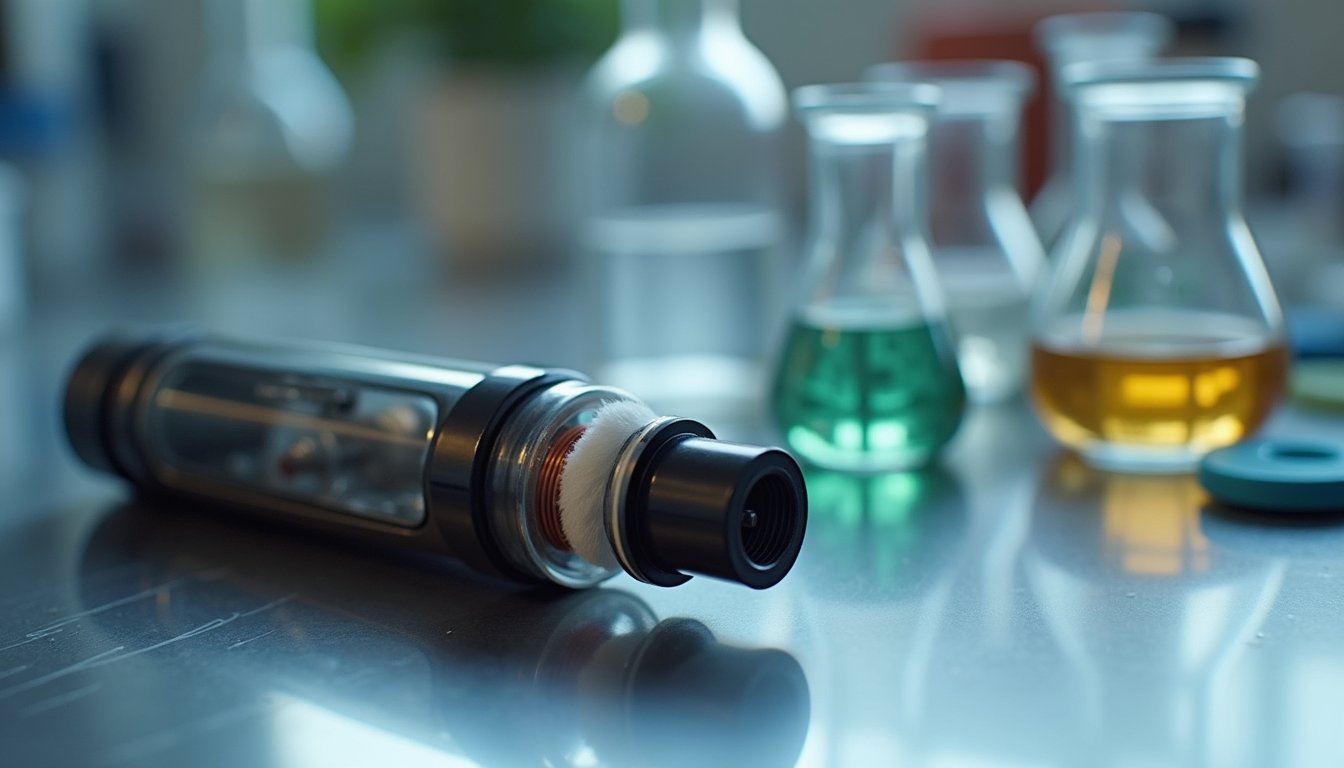Vaping addiction affects your brain through powerful nicotine reward pathways that create both pleasure and dependency. You’re exposed to highly concentrated nicotine levels from modern devices, which can lead to serious health risks including respiratory damage, cardiovascular issues, and long-term addiction. With the global vaping market reaching $24.6B in 2024, you’ll find widespread accessibility despite increasing regulations. Understanding the science, risks, and recovery strategies will equip you with essential knowledge to make informed decisions about vaping.
The Science Behind Vaping Dependency

How does vaping create such a powerful hold on the brain? When you vape, nicotine reward pathways in your brain’s dopamine system activate, delivering pleasurable effects at low doses while creating a cycle of dependency. Your brain’s chemistry fundamentally changes as nicotine interacts with acetylcholine receptors, affecting your executive function and decision-making abilities. Modern vaping devices deliver extremely high concentrations of nicotine compared to traditional cigarettes, intensifying the addiction potential. Researchers have discovered that neurons employ a long-lasting refractory period to protect against nicotine overstimulation.
Your brain does try to protect itself through medial habenula mechanisms, specifically using TMEM16A calcium-activated chloride channels to counteract nicotine overstimulation. However, this natural defense isn’t enough to prevent addiction. The complex interplay between rewarding effects at low doses and aversive effects at high doses keeps you trapped in a cycle of use. Your brain’s reward system becomes primed, making you more susceptible to other addictions and complicating the path to recovery. This challenge has become particularly evident as dual use of cigarettes emerges as a growing concern among young nicotine users.
Current Global Vaping Statistics and Trends
While brain chemistry explains addiction mechanisms, the global scale of vaping reveals an unprecedented market expansion. You’ll find the industry valued at $24.6B in 2024, with projections reaching $41.6B by 2033. The U.S. leads with $9.4B in revenue, followed by considerable markets in the UK, Canada, and China. Specialty e-cig shops remain the dominant retail channel due to their product expertise and variety. Over the past two years, the marketplace has seen a massive increase of more than 46% in both sales and brand variety.
Regional market trends show Western Europe and the U.S. dominating market share, while the Eastern Mediterranean region displays the highest per-capita adoption. Flavor preferences markedly impact consumer behavior, with 85% of adolescent users choosing flavored products. In fact, young people between 15-17 years demonstrate 16 times higher likelihood of vaping compared to those aged 25-34. You’re witnessing a surge in users globally, from 68M in 2020 to 82M in 2021. Digital retail expansion and perceived health benefits drive this growth, while customizable nicotine levels cater to diverse consumer needs.
Understanding Youth Vaping Epidemic

Despite recent declines in youth vaping rates, the terrain of adolescent e-cigarette use remains complex and concerning. While usage has dropped to 5.9% in 2024, marking a 70% decline since 2019, over 1.6 million youth still actively vape. Current youth vaping prevention strategies face regulatory enforcement challenges as flavored products dominate 90% of youth use. A significant portion of these products comes from an influx from China flooding the market with disposable vapes. Most young users prefer these devices because they contain addictive nicotine that can harm adolescent brain development.
- Picture a teen discreetly using a disposable vape device in school bathrooms
- Visualize colorful, candy-flavored vapes displayed alongside traditional menthol options
- Imagine enforcement officers seizing hundreds of illegal vapes from local retailers
- See a student experiencing nicotine withdrawal symptoms during class
- Envision advocacy groups protesting outside vape shops selling flavored products
The data reveals concerning patterns: over 40% of high school users vape frequently, with nearly 30% reporting daily use. Despite increased enforcement efforts, illegal devices and flavored products remain widely accessible to teens.
Health Risks and Long-Term Effects
When you vape, you’re exposing your respiratory system to harmful chemicals that can trigger chronic obstructive pulmonary disease (COPD), asthma, and potentially irreversible airway damage known as “popcorn lung.” Young people under 25 are especially vulnerable since nicotine can cause serious brain damage.
Your cardiovascular system faces significant risks, as nicotine contributes to heightened blood pressure and heart disease, especially if you’re among the 29.4% of vapers who also smoke traditional cigarettes.
Research in mice has shown that e-cigarette aerosol exposure leads to concerning rates of lung adenocarcinoma and bladder hyperplasia, suggesting serious long-term health consequences for human users. A comprehensive study of 250,000 participants over four years demonstrates that exclusive e-cigarette use is linked to increased risks of COPD and hypertension.
Respiratory System Damage
As e-cigarette use continues to surge worldwide, mounting evidence reveals severe respiratory health risks associated with vaping. E-cigarette emission toxicity includes ultrafine particles, metals, and volatile compounds that can trigger acute lung injuries. Research shows that users face increased risks of cough and wheezing, particularly among youth populations. Studies confirm that dual use risk is significantly higher compared to smoking alone.
Nicotine exposure effects extend beyond addiction, causing significant damage to your respiratory system and potentially leading to COPD – with exclusive vapers facing 2.29x higher risk than non-users.
- Toxic chemicals and metals settling deep within your lung tissue
- Microscopic particles causing inflammation and scarring in airways
- Progressive lung function decline leading to respiratory failure
- Development of lung adenocarcinomas observed in research studies
- Vitamin E acetate causing severe acute lung injury (EVALI)
This damage becomes particularly severe if you’re a dual user, combining traditional smoking with vaping, as the compounded effects target multiple airway pathways simultaneously.
Cardiovascular Impact Studies
Research from detailed cardiovascular impact studies reveals alarming findings about e-cigarette use and heart health. Your risk of heart attack doubles when you vape, while your chances of developing heart failure increase by 20%. Vascular dysfunction metrics show immediate damage to your blood vessels, with reduced nitric oxide production and impaired vasodilation. Studies show increased heart rate during acute exposure to e-cigarettes compared to non-use.
If you’re a dual user of both e-cigarettes and traditional cigarettes, you’re facing a 36% higher cardiovascular disease risk than cigarette-only smokers. The presence of nicotine in e-cigarettes raises blood pressure significantly. Inflammation biomarkers indicate heightened oxidative stress and systemic inflammation in your body.
Long-term studies demonstrate chronic vascular dysfunction, accelerated arterial aging, and increased aortic stiffness. Your pulse wave velocity measurements may predict higher cardiovascular event risks. These findings emphasize the severe cardiovascular impact of vaping on your heart health.
Breaking the Vaping Cycle: Recovery Strategies

Three key pillars form the foundation of successful vaping cessation: medication-based treatments, behavioral interventions, and holistic support systems. Creating personalized treatment plans begins with understanding your unique triggers and patterns. Varenicline, when combined with counseling, offers success rates up to 51% at 12 weeks, while cultivating self-awareness through mindfulness reduces stress-induced cravings. The program’s proven ability to increase quit odds by up to 40% demonstrates its effectiveness as a recovery tool.
- Picture yourself using the EX Program’s digital platform, tracking daily progress
- Visualize attending weekly counseling sessions, building new coping strategies
- Imagine replacing vaping rituals with calming breathing exercises
- See yourself joining community challenges like “You Got This Day”
- Envision creating a structured exercise routine to combat cravings
The most effective recovery combines FDA-approved medications, behavioral support, and lifestyle modifications, maximizing your chances of long-term success through a tailored approach.
Impact of New Regulations on Vaping Market
Sweeping regulatory changes are reshaping the global vaping terrain, with projected market growth reaching $33.16B by 2025 despite stricter controls. You’ll notice significant shifts in product availability as manufacturers adapt to flavor bans and synthetic cooling agent restrictions, particularly in states like California.
Despite tightening regulations, the vaping industry continues evolving, with manufacturers adapting to new restrictions while market value soars toward $33.16B.
Cross-state compliance has become increasingly complex, with varying regulations affecting distribution networks and pricing structure shifts. You’re likely to see higher prices in regions with online sales restrictions, as markets adjust to new maturity verification requirements and licensing systems.
In Europe, you’ll find even stricter measures, with Belgium banning disposable vapes entirely and Italy limiting sales to physical stores.
These changes are transforming how you’ll access vaping products, with manufacturers prioritizing regulatory compliance and retailers implementing advanced verification systems.
Demographics and Social Patterns of E-Cigarette Use
Recent demographic data illuminates clear patterns in e-cigarette use across maturity, gender, and usage intensity. You’ll find men consistently outpacing women in adoption rates, while young adults of prime years 21-24 represent the highest usage at 15.5%.
Though youth vaping has declined to 5.9% in 2024, adult use has rebounded to 6.5%. While socioeconomic factors and urban-rural disparities remain understudied, current usage patterns reveal significant insights.
- One in every 20 Americans now reports regular vaping behavior
- More than a third of users (38.4%) engage in frequent vaping sessions
- Daily use affects about a quarter (26.3%) of current users
- Youth usage dropped from 2.13 million to 1.63 million users
- Gender gaps persist without significant narrowing over recent years
Prevention Methods and Support Resources
A thorough array of prevention methods and support resources has emerged to tackle vaping addiction in 2025. You’ll find comprehensive digital tools like the EX Program, which combines Truth Initiative and Mayo Clinic expertise with personalized cessation strategies. Community-based support through local workshops and online forums provides vital peer connections and motivational incentives.
For medical intervention, you can access nicotine replacement therapy or prescription medications like varenicline, which offers 2.42-fold higher abstinence odds. Youth-specific programs through the American Lung Association target ages 13-19 with customized approaches, including stress management and replacement activities.
The “You Got This Day” initiative connects you with proven cessation methods, while structured counseling sessions help identify triggers and develop healthy alternatives for long-term success.
Frequently Asked Questions
Can Vaping Affect Fertility and Pregnancy Outcomes?
Yes, vaping can substantially impact your fertility and pregnancy outcomes. High nicotine absorption levels from vaping can reduce your ovarian reserve, lower sperm count, and impair sperm motility.
If you’re pregnant, vaping increases your risk of low birth weight and preterm delivery. Even secondhand vape exposure can harm reproductive health and fetal development.
You’ll face similar reproductive risks whether you’re using e-cigarettes or traditional cigarettes.
How Do Different Vaping Devices Compare in Terms of Addiction Potential?
Your addiction risk varies extensively across vaping devices. Pod-based systems with high nicotine concentration levels (up to 50mg/mL) typically create stronger dependencies than traditional e-cigarettes.
Device temperature settings also play a pivotal role higher temperatures deliver nicotine more efficiently, increasing addiction potential.
You’ll find disposable pods particularly risky due to their lack of customization options, while adjustable devices let you control nicotine intake, potentially reducing dependency risks.
What Happens to Used Vaping Devices and Their Environmental Impact?
When you dispose of vape devices improperly, they create significant environmental damage. Over 68% of users toss them in regular trash, leading to 4.5 devices discarded every second in the U.S. alone.
These devices contain toxic materials like heavy metals and lithium batteries that contaminate soil and water. For proper vape device disposal, you’ll need to seek specialized e-waste facilities, while vaping battery recycling requires separate handling at designated collection points.
Do Insurance Companies Cover Vaping Cessation Treatments and Counseling?
Your insurance coverage for vaping cessation depends on your provider. Medicare offers extensive coverage including medications and counseling sessions, while Medicaid benefits vary by state.
You’ll find most plans cover FDA-approved treatments and counseling through financial assistance programs. If you’re uninsured, you can access free resources like state quitlines (1-800-QUIT-NOW) and the EX Program, which provides personalized support and counseling via text messaging.
How Does Altitude or Extreme Weather Affect Vaping Device Performance?
High altitudes and extreme weather profoundly impact your vaping experience through vapor density variations and battery temperature fluctuations.
You’ll notice thicker oils become more viscous in cold weather, making them harder to vaporize. At higher elevations, lower air pressure can cause e-liquid expansion and potential leaks.
Your device’s battery performance will deteriorate in cold conditions, while extreme heat may affect vapor production and cartridge stability. You’ll need to adjust settings accordingly.










